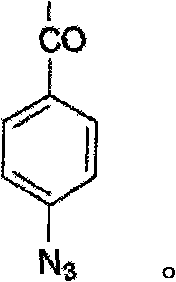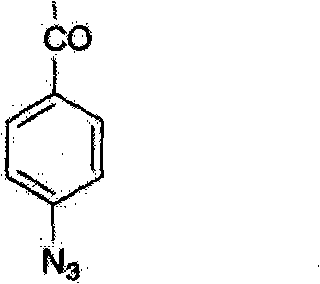Biological adhesive agent and use thereof
A bioadhesive and biomacromolecule technology, applied in the field of medical and bioengineering supplies, can solve problems such as low bonding strength, patients infected with blood viruses, and stimulate immune side effects
- Summary
- Abstract
- Description
- Claims
- Application Information
AI Technical Summary
Problems solved by technology
Method used
Image
Examples
Embodiment 1
[0015] Preparation of the present bioadhesive
[0016] Weigh 0.5 g of azidobenzoylated polylysine powder with a molar percentage of azidobenzoylation structural unit of 25%, place it in a small beaker, add 19.5 g of distilled water, stir and dissolve to obtain azidobenzoyl The bioadhesive with a weight percent concentration of acyl polylysine of 2.5% is sucked into the prepared bioadhesive with a 10ml injection needle and set aside.
Embodiment 2
[0018] Adhesion between active physiological tissues
[0019] New Zealand white rabbits were used as experimental animals. There were 3 New Zealand white rabbits, all male, weighing 2000g±150g. The experiment is divided into an experimental group and a control group, with the New Zealand white rabbit back spine as the boundary, the left side is the control group, the right side is the experimental group, the control group uses a blank control, and the experimental group uses the bioadhesive of the present invention. Rabbits were anesthetized by intravenous injection of 2% pentobarbital sodium aqueous solution at a dose of 30 mg / Kg body weight, and the rabbits were fixed on the operating frame with their backs facing up, and the back hair was shaved off with a razor blade , and use Promogeramine cotton balls for skin disinfection. Taking the central skin of the back spine as the boundary, use a sterilized scalpel blade to take a piece of skin with a length of 3 cm, a width of ...
Embodiment 3
[0022] Packing and trapping of physiological pipeline
[0023] Cut a section of the small intestine of the rat, 8 cm long, discharge the contents of the small intestine, ligate one end, insert the injection needle into the other end and then ligate, so that the injection needle is connected with the syringe; use another injection needle to pierce a small hole on the intestinal wall, and Place the ligated small intestine with a small hole in a beaker filled with water, push air into the ligated small intestine with a syringe, so that the intestinal tube is naturally filled, and the small intestine leaks air. Take the small intestine out of the water, drop a drop of this bioadhesive on the punctured part, irradiate with ultraviolet light for 2 minutes, and solidify, then put the small intestine into a beaker filled with water, and slowly push air into the intestinal tube with a syringe , no gas leaks from the small intestine. The test results show that the bioadhesive of the pr...
PUM
 Login to View More
Login to View More Abstract
Description
Claims
Application Information
 Login to View More
Login to View More - R&D
- Intellectual Property
- Life Sciences
- Materials
- Tech Scout
- Unparalleled Data Quality
- Higher Quality Content
- 60% Fewer Hallucinations
Browse by: Latest US Patents, China's latest patents, Technical Efficacy Thesaurus, Application Domain, Technology Topic, Popular Technical Reports.
© 2025 PatSnap. All rights reserved.Legal|Privacy policy|Modern Slavery Act Transparency Statement|Sitemap|About US| Contact US: help@patsnap.com


